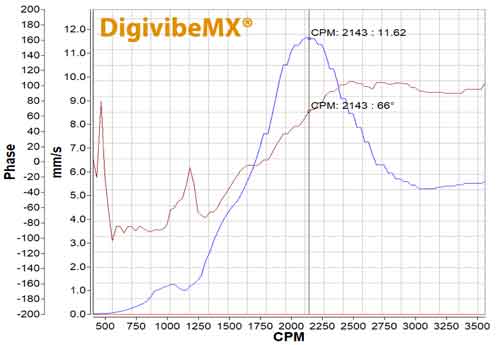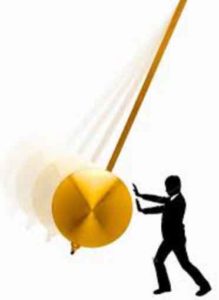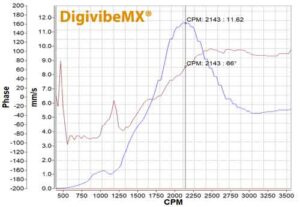Condition Monitoring: Resonance and Natural Frequency
Content Table

Have you ever tried to balance a fan and its vibration won’t go down, no matter what you do? This is possibly caused by resonance.
Three tips to diagnose resonance and six ways to correct it below.
Facts
Resonance accounts for 40% of recurrent unbalance cases and is also, despite being so easy to diagnose, one of the most overlooked faults.
Among the most common faults, resonance has the most destructive force. It is also the antagonist of 90% of structural fractures due to material and weld fatigue, as well as the reduction of bearing life caused by overloading.
Natural Frequency Definition
To understand resonance, we first need to understand what natural frequency is. The definition reads something like this:
Natural frequency is the frequency at which an object will continue to vibrate after being struck. This could not be clearer.
All mechanical objects and systems have a natural frequency. They can even have many natural frequencies depending on their geometry.
NOW! What happens when you excite that object to the same frequency as its natural frequency? Well, that’s resonance.
Resonance Definition
Resonance is a phenomenon that amplifies a vibration. It occurs when a vibration is transmitted to another object whose natural frequency is the same or very close to that of the source.
Also check Wikipedia’s Definition.
Examples
Look at the example of a pendulum.

When I push the pendulum, the energy I apply is not immediately lost. Instead, it remains in the form of movement of the pendulum that is gradually lost. If I push it once in each cycle, that new energy accumulates to the energy that was already in the pendulum in the form of movement, just like when you push your toddler on the swing.

Note the opposite case. When I stimulate the pendulum to a different frequency, I will be fighting against the energy that was already accumulated, therefore, no energy will be added to the existing one.
Something very similar happens in rotating machines. When the speed of a motor is close to its natural frequency, it will resonate. Thus, any vibration due to unbalance, however small, will be amplified. In this way, small masses will cause surprising changes in vibration.
Finally, as if all this were not enough, the vibration of a machine does not behave linearly. The amount of vibration produces small structural changes that momentarily modify the natural frequency as well as the damping, causing it to behave slightly differently at different vibration levels. All of this makes balancing complicated.
Resonance is easy to diagnose; however, it is important to know how to detect it. A machine, during operation, will gradually increase its vibration, resonance will cause the vibration to suddenly increase when the machine reaches its final speed. The same happens on “cool down”, when the RPM gains a small distance from the natural frequency, the vibration immediately decreases.
There are three types of tests you can perform to diagnose resonance.
Startup and Shutdown Test | Resonance
This test is performed by recording the vibration during machine shutdown. Confirm that indeed the vibration decreases drastically in the first few seconds.

Prueba de Paro
Bump Test | Natural Frequency
In the “bump test” the recording of the vibration is made after hitting the machine. In the spectrum, you will then observe the resonant frequencies of the structure. You can confirm the diagnosis within 95% certainty if any of those frequencies are close to the rotation speed (be sure you know with certainty the speed of rotation). Usually, this study is enough to diagnose resonance, however there is another test in the case of needing a confirmatory test.

Bump Test

Resonance Bump Test FFT
Bode Plot in Resonance Analysis
A Bode diagram is a coast down or run-up test that integrates vibration and RPM measured by a tachometer or RPM sensor. This test calculates the FFT and the phase related to the RPM signal at each time interval. This test confirms the resonance by observing a change in the 180º phase between the moments before and after crossing the suspected frequency.

Correct Resonance
The good news is that the resonance phenomenon is easy to correct. Simply move the natural frequency away from the excitation frequency.
Correction actions are divided in two:
Modify the Natural Frequency
You can increase the natural frequency by increasing the rigidity of the structure. Make sure to reinforce the structure in the same direction of the natural frequency. This is the most common solution to avoid changing the performance of the machine.
You can also decrease the natural frequency by removing rigidity to the structure. It is not as common, but it is equally possible and effective, provided that the performance of the machine is not compromised.
You can decrease the natural frequency by adding mass. Changing the mass of a structure will change its natural frequency and therefore also move it away from its rotation speed.
You can also increase the natural frequency by removing mass. This is the least frequent action, but it is equally effective.
Modify the RPM to Move Them Away from the Natural Frequency
If a drive controls the motor speed, then change the RPM. It is the simple thing to do. In the case of having a belt/pulley transmission, changing the diameter of the pulley could be the solution. In any case, it is important to verify that the performance of the machine remains enough for its functions, and of course that the current consumption does not exceed the manufacturer´s recommendation.
Dr. Thierry Erbessd, a prominent Mexican entrepreneur, and graduate of the National Polytechnic Institute has revolutionized the field of Vibration Analysis, Dynamic Balancing, and Condition Monitoring. Through his innovative software DigivibeMX®, DragonVision®, and WiSER Vibe®, he has set a before and after in the industry. As president of Erbessd Instruments®, he has not only led the company to the top of the global industrial maintenance industry but has also expanded its influence with strategically located offices in America, Europe, and Asia, establishing himself as an undisputed reference in industrial maintenance solutions worldwide.
ERBESSD INSTRUMENTS® is a leading manufacturer of Vibration Analysis Equipment, Dynamic Balancing Machines, and Condition Monitoring with facilities in Mexico, the USA, England, and India








